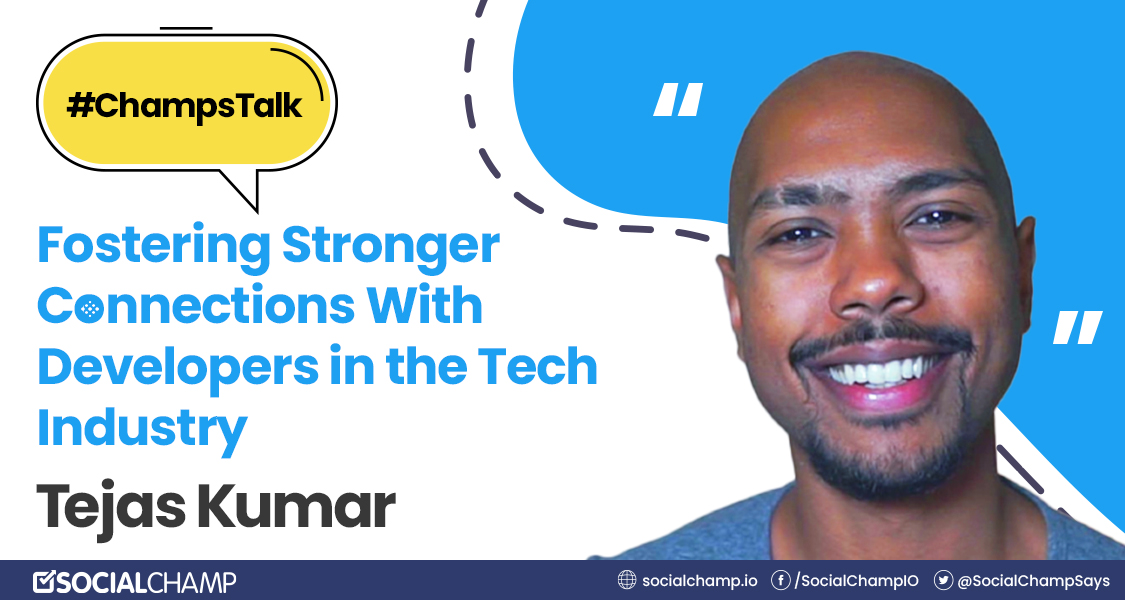Tejas Kumar, a developer relations consultant. He helps developer-oriented companies that work on DevTools establish strong relationships with developer communities and vice versa. So often, developers may want to achieve specific outcomes but might not be aware of certain tools. He ensures they are informed about what’s at their disposal in such cases. For the companies, he ensures that developers are aware of their presence. His primary focus is on building these relationships with a high level of quality. He’s excited to discuss all of this with you.
Neha K: Can you share insights into your experience helping dev tools companies improve their Developer Relations (DevRel) strategies? What are some common challenges they face in this process?
Indeed, drawing from my experience let me provide insights into aiding dev tools companies in enhancing their Developer Relations (DevRel) strategies. One notable example that stands out is a remarkable developer tool called Hasura. This Indian-built tool excels in creating awareness, which is a critical aspect of DevRel. The challenge lies in making developers aware of its existence and comprehending its capabilities, as it can seamlessly connect to databases. Hasura addresses this challenge effectively.
Moving forward, three common challenges arise in this realm. The first challenge is awareness, where companies struggle to ensure developers are acquainted with their tools and understand what they can achieve with them. Second, comes adoption, ensuring that developers incorporate the tools into their projects once awareness is established. The question is whether they merely know about it or actively utilize it. Overcoming this barrier involves in-depth analysis.
Lastly, adhesion, or stickiness, emerges as the third challenge. This pertains to the extent to which developers consistently use the tool, finding it indispensable enough to invest in. The aim is to reach a point where developers willingly choose to pay for the tool due to its effectiveness in resolving their issues and freeing them to focus on their core products. These three challenges—awareness, adoption, and adhesion—are universal in the realm of DevTools companies. Addressing them requires a well-crafted DevRel strategy, which my organization specializes in assisting these companies.
Neha K: As someone who focuses on loving and serving people, how do you approach building solid relationships with developers and fostering a thriving developer community for the companies you work with?
Absolutely, staying updated and maintaining relevant DevRel strategies in the ever-evolving tech landscape is pivotal. The crux lies in active participation in events, especially conferences. Attending these events offers exposure to informative talks and provides the invaluable “hallway track” where spontaneous discussions and networking occur. Conferences serve as a rich source of insights, enabling me to grasp the latest trends, technologies, and industry shifts firsthand.
Following the right accounts on platforms like Twitter contributes to staying informed about emerging developments, as these accounts often share insightful content and spark discussions. Engaging with such content helps keep a finger on the pulse of industry opinions and trends, further enhancing my knowledge.
Furthermore, understanding the focus areas—awareness, adoption, and adhesion—is crucial in DevRel. I advocate for open and comprehensive discussions to tackle the challenge of companies not having clear expectations from DevRel. Prioritizing in-depth conversations about goals and outcomes is vital. Businesses need to introspect about what they seek to achieve through DevRel, whether it’s generating awareness, fostering adoption, or driving adhesion. Defining these objectives in advance makes the entire process more targeted and effective.
I employ a strategic approach to plan and execute successful events that resonate with developers and align with the DevTools companies I’m associated with. Considering its unique value proposition, I identify the fitting developer audience for the product. For instance, if the product simplifies database API creation, I would target front-end developers looking for efficiency in building processes.
Upon pinpointing the suitable events for engagement, the decision to sponsor or merely attend is weighed based on the intended level of interaction. Sponsoring conferences provides opportunities for deeper engagement, including demos and booth interactions. However, regardless of sponsorship, the “hallway track” remains a valuable platform for spontaneous conversations that often yield invaluable insights.
In summary, staying updated in DevRel involves a mix of event participation, following industry leaders, and aligning strategies with the goals of DevTools companies. By fostering clear expectations and embracing the broader aspects of being social in the tech community, DevRel practitioners can ensure their strategies remain relevant, impactful, and responsive to the evolving landscape.
Kulsoom: In the context of DevRel, what are the key elements contributing to a successful and impactful developer outreach program?
Certainly, several key elements stand out when it comes to a successful and impactful developer outreach program. First and foremost, strong branding plays a pivotal role. An example like Evil Rabbit’s branding for Versel illustrates how a recognizable logo and identity can resonate deeply with developers. Likewise, companies like Hasura showcase the power of effective branding to establish a lasting connection.
Secondly, ensuring an exceptional developer experience is crucial. Inviting developers to engage with your tool and gathering their feedback gives you valuable insights into usability and potential improvements. This feedback-driven approach ensures optimized developer experience, addressing issues like the cohesion of different package managers in CLI tools.
Thirdly, meticulous measurement and tracking are essential. Analyzing metrics like UTM codes helps discern the effectiveness of various DevRel efforts in driving awareness and engagement. Such insights enable prioritizing strategies that yield the highest return on investment. Whether written content versus conference talks, clear data-driven decisions can be made to optimize resources.
Combining strong branding, a focus on a seamless developer experience through feedback, and comprehensive data analysis for informed decision-making constitutes the core pillars of a successful and impactful developer outreach program. These elements collectively foster genuine engagement and meaningful relationships with the developer community.
Kulsoom: Devtools companies often deal with technical products. How do you communicate complex technical concepts to developers in a way that resonates with them and encourages adoption?
Absolutely, this question delves into a fundamental aspect of developer relations. Effectively communicating complex technical concepts to developers in a relatable manner requires a multifaceted approach. Personally, I believe in immersing myself deeply in the product’s intricacies—comprehending its strengths, weaknesses, and nuances. Once armed with this knowledge, I strive to break down these technicalities into plain English, akin to the philosophy of Dr. Richard Feynman, who emphasized that true understanding is reflected in one’s ability to explain a subject in simple terms.
To achieve this, I recommend diligently reading through the entire documentation of the product and engaging with the development team to comprehend the rationale behind its creation. I can better convey its value proposition by knowing the “why” behind the product. However, it’s essential to distinguish between conveying value and attempting to convince or persuade. Convincing people to adopt tools is a marketing function; DevRel, on the other hand, revolves around fostering relationships based on authenticity and understanding.
Successful DevRel involves presenting technical concepts in a language developers can quickly grasp, showcasing the product’s merits, and letting its value resonate naturally. This approach establishes a solid foundation for building meaningful relationships with developers and encouraging genuine adoption, ultimately driving the growth and success of DevTools companies.
Neha K: Collaboration and partnerships are essential in the developer ecosystem. How do you identify and nurture potential partnerships to enhance a dev tools company’s presence within the developer community?
Indeed, your insight about the fine line between DevRel and various other facets within an organization is genuinely perceptive. This delineation holds true for sales, engineering, and other departments. I believe this synergy between different teams is where partnerships thrive and make a meaningful impact. When considering practical ways to form partnerships and amplify a dev tools company’s presence within the developer community, events often serve as valuable platforms.
Attending events provides the opportunity to witness various products in action, opening doors to potential partnerships. It’s not uncommon to encounter a promising product at a conference booth, sparking conversations about awareness, adoption, and adhesion—the core pillars of a successful DevRel effort. I’ve encountered instances where a product demo captivated me, and I realized that more people should know about it. Engaging in dialogues about these aspects enables the fostering of partnerships that can mutually benefit both sides.
For instance, a developing relationship with Gluestack, an Indian-based framework for universal apps, showcases the process of nurturing partnerships. This collaboration demonstrates how working together can create broader awareness, foster adoption, and enhance adhesion for their product. In summary, recognizing the thin lines connecting DevRel with other verticals, actively engaging at events, and fostering relationships emphasizing shared goals are key to identifying and nurturing partnerships that elevate a dev tools company’s presence within the developer community.
Neha K: Metrics play a crucial role in measuring the effectiveness of DevRel efforts. Which metrics do you find most valuable for evaluating the success of developer outreach, and how do you use them to drive continuous improvement?
The topic you brought up about the thin lines between roles within DevRel is vital, especially for those entering the field. Recognizing and setting clear boundaries prevents burnout and promotes a healthier work-life balance, contributing to long-term success in DevRel endeavors. Now, let’s delve into the metrics aspect.
Metrics are essential for evaluating the effectiveness of DevRel efforts, and they vary depending on the focus—awareness, adoption, or adhesion. Each of these areas presents distinct key performance indicators that help gauge success. For example, in the realm of awareness, metrics like the volume of blog posts, conference engagements, and inbound leads are valuable indicators of visibility and engagement.
For adoption, metrics pivot towards sign-ups and activations, revealing how effectively developers are adopting the tools. If sign-ups don’t convert to usage, further analysis is needed to pinpoint any friction points. On the other hand, adhesion metrics encompass more advanced aspects like customer retention, conversion to paid plans, and engagement in workshops or hackathons. These metrics offer insights into the stickiness of the product and its value to users.
However, it’s crucial to remember that metrics aren’t one-size-fits-all. They’re influenced by the organization’s goals, budget, and product offerings. Whether it’s an open-source tool evolving into a cloud-native service like Hasura or catering to enterprise on-prem solutions, the metrics align with the product’s lifecycle and its intended audience.
In essence, the effectiveness of DevRel efforts hinges on understanding which of the three A’s—awareness, adoption, or adhesion—is the primary focus. Metrics tailored to each phase provide a clear picture of progress and areas that need attention, ultimately driving continuous improvement and fostering stronger relationships within the developer community.
Kulsoom: With the ever-evolving tech landscape, how do you stay updated and ensure that your strategies for DevRel remain relevant and impactful?
In the dynamic world of technology, staying updated and ensuring impactful DevRel strategies is paramount. For me, attending events, particularly conferences, holds immense value. I invest a significant amount of time in conferences because they provide unique opportunities to gain insights that are often unparalleled in one’s career. These events contribute through the informative talks and the invaluable “hallway track,” where impromptu conversations spark new ideas and connections. Attending React Rally, I had a serendipitous encounter with Kent C. Dodds, leading to a discussion about Remix and its capabilities, which later inspired a blog post.
In addition to physical events, staying connected digitally is crucial. Following the right accounts on platforms like Twitter keeps me updated with trends and discussions within the tech community. It’s fascinating how reactions and opinions on platforms like Exponentials (X) can give real-time insights into the current industry discourse. This broader approach to being socially engaged plays a pivotal role in my continuous learning process.
Now, circling back to the challenge I’ve faced in DevRel companies struggling to articulate their expectations—finding a solution requires open communication and clarity. I advocate for businesses to introspect deeply about their DevRel goals and outcomes. Identifying what they seek out of DevRel—be it awareness, adoption, or adhesion is a fundamental step. These objectives should align with their budgeting and overall strategies. Addressing this challenge often involves collaborative workshops where stakeholders, including investors, contribute to defining clear objectives and desired outcomes.
When it comes to planning and executing events for developer engagement and promoting the DevTool companies I work with, it’s essential to consider where the product fits within the developer landscape. By understanding the unique value proposition and identifying the target audience, I can select events that resonate with developers’ needs and priorities. For instance, if the product simplifies API creation, I’d aim for events that attract developers seeking efficient backend solutions, like React Advanced London.
Whether a company sponsors an event or engages organically, the focus remains on fostering relationships and creating meaningful interactions. These interactions are not promotions but rather opportunities to connect with developers, understand their pain points, and showcase how the product addresses their needs. Successful events can be planned and executed by staying authentic and ensuring alignment between product benefits and developer preferences.
To wrap up, embracing a multi-faceted approach involving physical attendance at events and active digital engagement through platforms like Twitter helps me stay updated. Combining this with strategic workshops to address challenges and thoughtful event planning ultimately leads to impactful and relevant DevRel strategies.
Neha K: Community events and conferences are essential for developer engagement. How do you plan and execute successful events to connect with developers and promote the dev tools companies you represent?
Planning and executing successful community events and conferences for connecting with developers and promoting dev tools companies requires a thoughtful approach. It begins with understanding developers’ needs through market research and conversations. Relevant events are chosen based on these insights, focusing on providing engaging content such as technical talks, case studies, and live demos. The goal is to foster meaningful interactions and relationships, creating an environment for developers to network and learn from one another.
By highlighting actual use cases and offering hands-on experiences, attendees can see the value of the dev tool firsthand. Measuring the impact of the events through engagement metrics and collecting feedback allows for continuous improvement, ensuring that future engagements are even more effective in addressing developers’ needs and promoting the dev tools’ value.
We thank Tejas Kumar for taking his precious time for our Live session and sharing valuable knowledge with our audience.






